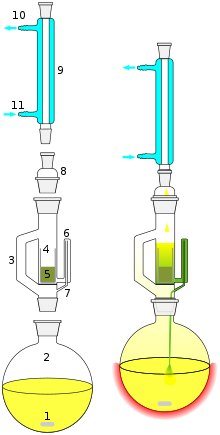
Back جهاز سوكسلت Arabic Extractor Soxhlet Catalan Soxhletův extraktor Czech Soxhlet Danish Soxhlet-Aufsatz German Εκχυλιστής Σόξλετ Greek Soxhlet extractor English Extractor Soxhlet Spanish Soxhleti ekstraktor Estonian Soxhlet erauzgailu Basque

1: Stirrer 2: Still pot 3: Distillation path 4: Thimble 5: Solid 6: Siphon top 7: Siphon exit 8: Expansion adapter 9: Condenser 10: Cooling water in 11: Cooling water out

A Soxhlet extractor is a kind of laboratory equipment. It is made of glass. Franz von Soxhlet invented it in 1879. It has a flask, an extraction chamber, and a condenser. It can be used for solid-liquid extractions.
In this discontinuous extraction process, the extraction solvent inside the boiling flask is evaporated and re-condensed in the distillation column above. It then falls down onto the solid material requiring extraction. The chamber containing the solid material is connected to the boiling flask below by a syphoning mechanism seen in the Pythagorean cup, which allows the chamber to fill to a point, at which it will empty its contents and start to fill again and the extracted compounds will accumulate in the boiling flask below.